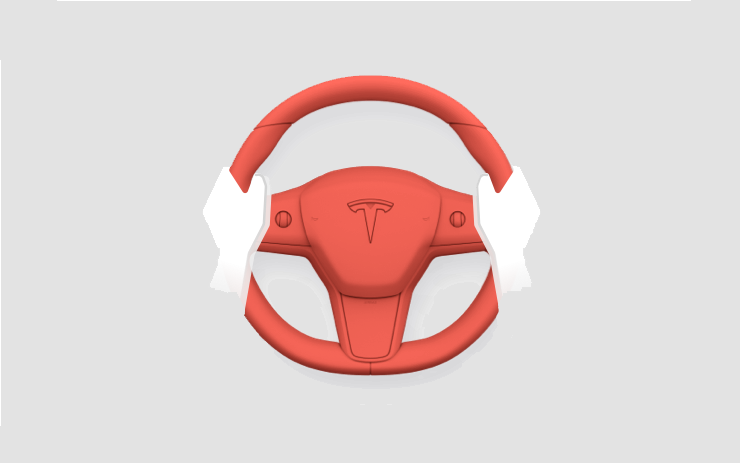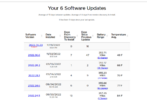Welcome to Tesla Motors Club
Discuss Tesla's Model S, Model 3, Model X, Model Y, Cybertruck, Roadster and More.
Register
Install the app
How to install the app on iOS
You can install our site as a web app on your iOS device by utilizing the Add to Home Screen feature in Safari. Please see this thread for more details on this.
Note: This feature may not be available in some browsers.
-
Want to remove ads? Register an account and login to see fewer ads, and become a Supporting Member to remove almost all ads.
You are using an out of date browser. It may not display this or other websites correctly.
You should upgrade or use an alternative browser.
You should upgrade or use an alternative browser.
FSD Beta 10.69
- Thread starter Buckminster
- Start date
TeslaFi allows showing pending installs if you enter in any firmware version number in the query param, but it will only show the installed history with the "TeslaFi firmware version" which includes the hash. (It looks like it's "<version> <hash>" sliced to the first 20 characters…I don't see any installed history ...
Looks like TeslaFi's software tracker main page was just updated to show pending versions (those without any completed installs) instead of needing to guess at the firmware version and editing urls:
EVNow
Well-Known Member
Interesting.TeslaFi allows showing pending installs if you enter in any firmware version number in the query param, but it will only show the installed history with the "TeslaFi firmware version" which includes the hash. (It looks like it's "<version> <hash>" sliced to the first 20 characters…) Both Teslascope and TeslaFi can see the pending version to be installed but can't see the hash until a vehicle actually installs it.
I don't add a version to the releases spreadsheet I maintain unless it comes on Teslafi. So, will have to wait .... (thats why no V11 on my sheet either).
AlanSubie4Life
Efficiency Obsessed Member
Could it be…finally…repeater cams in a useful location? This is going to be the most significant release in months.
Both Teslascope and TeslaFi are each showing 7 pending download/installs of 10.69.3.1 right now!
Edit: Up to 24 Teslascope and 75 TeslaFi pending! Roughly 2% rollout so far. And first 3 TeslaFi installs are from 2022.36.6, so new additions!
Edit: Up to 24 Teslascope and 75 TeslaFi pending! Roughly 2% rollout so far. And first 3 TeslaFi installs are from 2022.36.6, so new additions!
Last edited:
Downloading it now .Both Teslascope and TeslaFi are each showing 7 pending download/installs of 10.69.3.1 right now!
Edit: Up to 24 Teslascope and 69 TeslaFi pending! Roughly 2% rollout so far.
FYI I just got 2022.36.20 based on other updates could this be it... Installing it now I am not in beta currently.
Quot
Actually, none of Teslascope's 24 vehicles updating to 10.69.3.1 are from 10.69.2.x:
So it's only going to new additions or those already on 10.69.3 (e.g., some pre-Safety-Score testers).
Code:
1 2022.15.102
1 2022.20.7
2 2022.20.9
2 2022.36.15 (10.69.3)
18 2022.36.6So it's only going to new additions or those already on 10.69.3 (e.g., some pre-Safety-Score testers).
This is were I was at.Actually, none of Teslascope's 24 vehicles updating to 10.69.3.1 are from 10.69.2.x:
Code:1 2022.15.102 1 2022.20.7 2 2022.20.9 2 2022.36.15 (10.69.3) 18 2022.36.6
So it's only going to new additions or those on 10.69.3.
Attachments
powertoold
Active Member
Actually, none of Teslascope's 24 vehicles updating to 10.69.3.1 are from 10.69.2.x:
Code:1 2022.15.102 1 2022.20.7 2 2022.20.9 2 2022.36.15 (10.69.3) 18 2022.36.6
So it's only going to new additions or those on 10.69.3.
The intern accidentally sent it to the wrong group!
Release notes seem to be available elsewhere as notateslaapp don’t seem to have them

 tesla-info.com
tesla-info.com

Tesla 2022.36.20 Release Notes
Tesla 2022.36.20 release notes with full details generated by real cars
- Added a new "deep lane guidance" module to the Vector Lanes neural network which fuses features extracted from the video streams with coarse map data, i.e. lane counts and lane connectivities. This architecture achieves a 44% lower error rate on lane topology compared to the previous model, enabling smoother control before lanes and their connectivities becomes visually apparent. This provides a way to make every Autopilot drive as good as someone driving their own commute, yet in a sufficiently general way that adapts for road changes.
- Improved overall driving smoothness, without sacrificing latency, through better modeling of system and actuation latency in trajectory planning. Trajectory planner now independently accounts for latency from steering commands to actual steering actuation, as well as acceleration and brake commands to actuation. This results in a trajectory that is a more accurate model of how the vehicle would drive. This allows better downstream controller tracking and smoothness while also allowing a more accurate response during harsh maneuvers.
- Improved unprotected left turns with more appropriate speed profile when approaching and exiting median crossover regions, in the presence of high speed cross traffic ("Chuck Cook style" unprotected left turno). This was done by allowing optimizable initial jerk, to mimic the harsh pedal press by a human, when required to go in front of high speed objects. Also improved lateral profile approaching such safety regions to allow for better pose that aligns well for oxiting the region. Finally, improved interaction with objects that are entering or waiting inside the median crossover region with better modeling of their future intent.
- Added control for arbitrary low-speed moving volumes from Occupancy Network. This also enables finer control for more precise object shapes that cannot be easily represented by a cuboid primitive. This required predicting velocity at every 3D voxel. We may now control for slow-moving UFOs.
- Upgraded Occupancy Network to use video instead of images from single time step. This temporal context allows the network to be robust to temporary occlusions and enables prediction of occupancy flow. Also, improved ground truth with semantics-driven outlier rejection, hard example mining, and increasing the dataset size by 2.4x.
- Upgraded to a new two-stage architecture to produce object kinematics (e.g. velocity, acceleration, yaw rate) where network compute is allocated (objects) instead of O(space). This improved velocity estimates for far away crossing vehicles by 20%, while using one tenth of the compute.
- Increased smoothness for protected right turns by improving the association of traffic lights with slip lanes vs yield signs with slip lanes. This reduces false slowdowns when there are no relevant objects present and also improves yielding position when they are present.
- Reduced false slowdowns near crosswalks. This was done with Improved understanding of pedestrian and bicyclist intent based on their motion.
- Improved geometry error of ego-relovant lanes by 34% and crossing lanes by 21% with a full Vector Lanes neural network update. Information bottlenecks in the network architecture wore eliminated by increasing the size of the per-camera feature extractors, video modules, internals of the autorogressive decoder, and by adding a hard attention mechanism which greatly improved the fine position of lanes.
- Made speed profile more comfortable when creeping for visibility, to allow for smoother stops when protecting for potentially occluded objects.
- Improved recall of animals by 34% by doubling the size of the auto-labeled training set,
- Enabled creeping for visibility at any intersection where objects might cross egos path, regardless of presence of traffic controls.
- Improved accuracy of stopping position in critical scenarios with crossing objects, by allowing dynamic resolution in trajectory optimization to focus more on areas where finer control is essential.
- Increased recall of forking lanes by 36% by having topological tokons participate in the attention operations of the autoregressivo decoder and by increasing the loss applied to fork tokens during training.
- Improved velocity error for pedestrians and bicyclists by 17%, espocially when ego is making a turn, by improving the onboard trajectory estimation used as input to the neural network.
Those notes are from 10.69 from August. The notes for 10.69.3.1 are the same as those from 10.69.3 from earlier this month: FSD Beta 10.69Release notes seem to be available elsewhere as notateslaapp don’t seem to have them
Those notes are from 10.69 from August. The notes for 10.69.3.1 are the same as those from 10.69.3 from earlier this month: FSD Beta 10.69
Look different to 10.69.3 to me. There’s a screenshot floatinggaround
Interesting. I wonder if new additions get some aggregation of previous notes? Here's 10.69 from notateslaapp showing the same as the screenshot: FSD Beta 10.69 (2022.16.3.10) Official Tesla Release Notes - Software UpdatesThere’s a screenshot floating around
Yep, after you commented I went back and can see what you mean about the repetition. Most of the notes are “under the cover” stuff that change performance rather than add whole new aspects so it’s probably not massively important. The feedback from those using it will be real test.Interesting. I wonder if new additions get some aggregation of previous notes? Here's 10.69 from notateslaapp showing the same as the screenshot: FSD Beta 10.69 (2022.16.3.10) Official Tesla Release Notes - Software Updates
Is it 69.3.1 or 69.3.10 that is dropping? TeslaFi shows 69.3.1 so is the Notateslaapp a typo?Interesting. I wonder if new additions get some aggregation of previous notes? Here's 10.69 from notateslaapp showing the same as the screenshot: FSD Beta 10.69 (2022.16.3.10) Official Tesla Release Notes - Software Updates
According to Tesla-info it’s Software 2022.36.20 which includes FSD v10.69.3.1 which also seems to tally with the screenshotsIs it 69.3.1 or 69.3.10 that is dropping? TeslaFi shows 69.3.1 so is the Notateslaapp a typo?
Zane Liu
Member
I’m seeing it’s going to some new testers. I don’t see the beta for me yet but I’m really hoping soon now. Seems Tesla May be widened again. Im really hoping!
Similar threads
- Article
- Replies
- 56
- Views
- 11K
- Replies
- 19
- Views
- 2K
- Replies
- 97
- Views
- 5K
- Replies
- 9
- Views
- 4K
- Replies
- 25
- Views
- 4K



